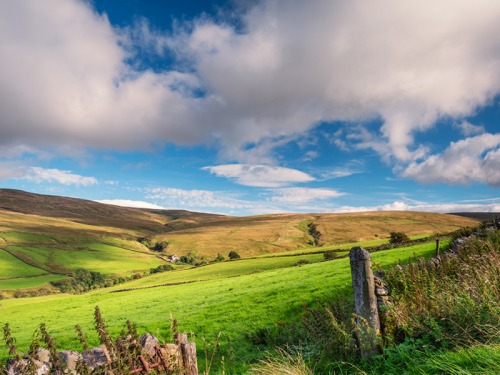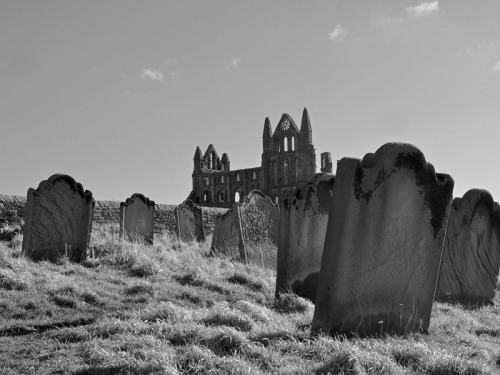Three Sacred Places in Yorkshire With a Unique History

You’ll learn plenty about our history when you explore these sacred places
‘Everywhere peace, everywhere serenity, and a marvellous freedom from the tumult of the world.’ This was the first impression made by Rievaulx Abbey upon Aelred, a young man from an influential Scottish family, and a steward to King David I of Scotland.
Aelred was sent, on the king’s behalf, to pay a visit to Archbishop Thurstan of York in 1134. However, calling at Rievaulx Abbey on the way, he spontaneously requested and was granted admission as a novice. By 1147 he was abbot, a position he held until his death. These were Rievaulx’s greatest years, with the monastery blossoming under his influence while monks and lay brothers joined in their hundreds. Through his preaching and writing, word spread of Aelred’s wisdom, compassion and dynamism.
Arriving at this hauntingly beautiful place on a bend in the River Rye, it is almost impossible not to share those initial, 900-year-old impressions of Aelred’s. The abbey is, of course, a ruin and is now in the care of English Heritage. It is also an archaeological site where digs and studies continue to throw light on the astonishing extent and industry of Rievaulx.
As at Fountains, the main abbey walls are surprisingly intact; I found this sense of surprise enhanced when I craned my neck up to the shafts where the ribs of vaulting once sprung, to see a wheeling buzzard silhouetted against the clouds as I rewound through the ages.
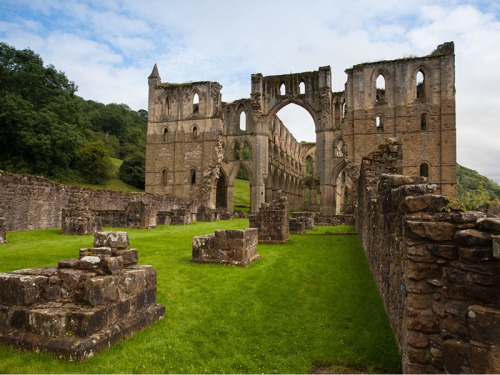
Rievaulx was founded in 1132 when St Bernard of Clairvaux sent a dozen monks from France to found the first Cistercian outpost in northern England. The monks were granted the present site and a substantial holding of land by the pious Walter Lese, Lord of Helmsley. However, it was the elevation of Aelred to the abbotship that transformed the fortunes of the monastery.
Aelred became recognised as England’s pre-eminent theologian and even travelled to Westminster Abbey in 1163 to preach in the presence of King Henry II. He was famed as an arbitrator and negotiator of peace. However, despite hobnobbing with royalty, his holiness was evident in his extreme personal austerity. As related by Walter Daniel: ‘he had built a small chamber of brick under the floor of the novice house, like a little tank, into which water flowed like hidden rills… Aelred would enter this contrivance when he was alone and undisturbed, and immerse his whole body in the icy cold water and so quench the heat in himself of every vice.’
Unlike at Fountains, come the Dissolution of the Monasteries Rievaulx’s best days were already long behind it. After Aelred’s time the community faced terrible difficulties, including financial problems, famine and disease. Worst was the Black Death in 1348–49. When Henry VIII’s commissioners turned up in 1538, there were just 24 poverty-stricken monks remaining.
While the ruins of Rievaulx are constant evokers of the imagination as you wander among them, there is no disputing that the best views of the abbey are from the spectacularly landscaped Rievaulx Terrace and Temples on the steep hillside above. The terraces were laid out in 1758 by Thomas Duncombe, who owned the land and the adjoining Helmsley Estate, at the height of the landscaping craze. There are two ‘temples’ – follies, really – on the site. Both were constructed above Rievaulx so that the abbey ruins could be viewed through gaps in the trees on the slopes below.
Read More: Meet the TikTok Time Traveller Sharing North East History Videos on the Popular App
Of York’s sacred sites, the Shrine of St Margaret Clitherow is the easiest to miss despite being about half way along The Shambles, York’s quaintest, most famous and best preserved medieval alley. I did not find it hard to imagine the blood and offal, the squelch underfoot and stench which carried the street’s name into the English lexicon to mean a ‘mess’ or ‘muddle’, after the butchers’ shops that once concentrated here.
It was to such a background that Margaret Clitherow was sent to her own gruesome death and became a Catholic martyr in the newly Protestant England of 1584. Margaret (n.e Middleton) was the daughter of a wax merchant who in1571 married John Clitherow, a butcher on The Shambles, and had three sons. Three years later she converted to Catholicism, an action for which her Protestant husband had to pay her fines for not attending Protestant services as the law required. However, Margaret’s devotion to her church went much further than most recusants. She secretly instructed her children in the Catholic faith; she had a concealed cupboard in which clerical vestments, bread and chalice wine for mass were stored; and – most dangerously and illegally – she gave sanctuary to Catholic clergy on the run and had a secret ‘priest’s hole’ cut from her attic to the house next door, through which fugitives could flee if there was a raid.
‘There is now a discreet little chapel and shrine to the martyr who was finally canonised by Pope Paul VI in 1970’
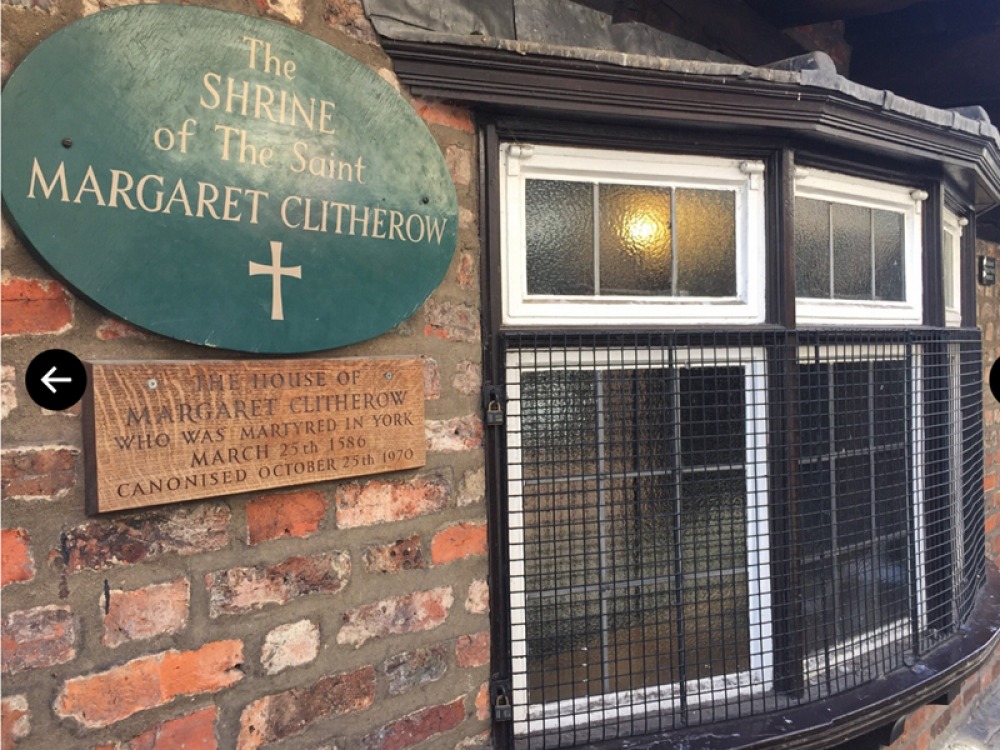
In 1586 there came a crackdown. Margaret was arrested, charged with harbouring papist priests and imprisoned. Her children were taken to live with a Protestant family; she never saw them again. Her husband was permitted to visit her just once, in the presence of a gaoler. And when her case came to court a large crowd gathered to hear her plea. But Margaret said only, ‘I know of no offence whereof I should confess myself guilty. Having made no offence, I need no trial.’
Pronouncing the penalty for refusing to plea, the judge told her that she should be ‘stripped naked, laid down, your back on the ground, and as much weight laid upon you as you were able to bear, and so to continue for three days without meat or drink, and for the third day to be pressed to death, your hands and feet tied to posts, and a sharp stone under your back.’ Ten days later, on Good Friday 1586, the sentence was carried out.
All this is recounted in the ‘Margaret Clitherow Story’, a leaflet on in the little former butcher’s shop on The Shambles where the Clitherows lived and suffered. There is now a discreet little chapel and shrine to the martyr who was finally canonised by Pope Paul VI in 1970. It consists of just a single, small downstairs room, a plaque on the wall telling her story, and a simple statue of the saint behind a low altar where pilgrims offer prayers. At the time of my visit I was joined by a lady from New Zealand who whispered to me, ‘One thing nobody knew is that Margaret was pregnant again at the time of her martyrdom.’ Well I never.
Precious little remains of York Castle, the city fortification established by William the Conqueror, other than the sturdy stone keep known as Clifford’s Tower. This is the site of an infamous massacre of Jews which has caused the tower to loom large in Anglo-Jewish history. Some Jewish pilgrims compare the heroic happenings at Clifford Tower to the mass suicide at Masada in the 1st century AD.
By the early 12th century York had a large, wealthy and well-established Jewish community. However, the accession of crusading King Richard (The Lionheart) to the throne of England in 1189 heralded an era of burgeoning anti-Jewish sentiment throughout the country. Jews had been banned from Richard’s coronation in Westminster Abbey, and there had been isolated attacks on Jews and their property in London and other towns. Then, on the night of 16 March 1190 (the Jewish feast of Shabbat Ha-Gadol), about 150 Jews fled York’s Jewish quarter as it came under attack. They took refuge in the castle keep which was besieged all night by a frenzied mob brandishing torches and calling for their slaughter. The rabbi, Yom Tom of Joigny, called on the Jews to take their own lives rather than fall into the hands of their persecutors. Some did, with men killing their wives and children first. As flames engulfed the tower, the survivors who emerged were massacred.
‘Jewish history is something York’s tourism authorities are keen to highlight. There is a walking map of the city’s medieval Jewish quarter, for example, along streets with names such as Jewbury and Jubbergate’
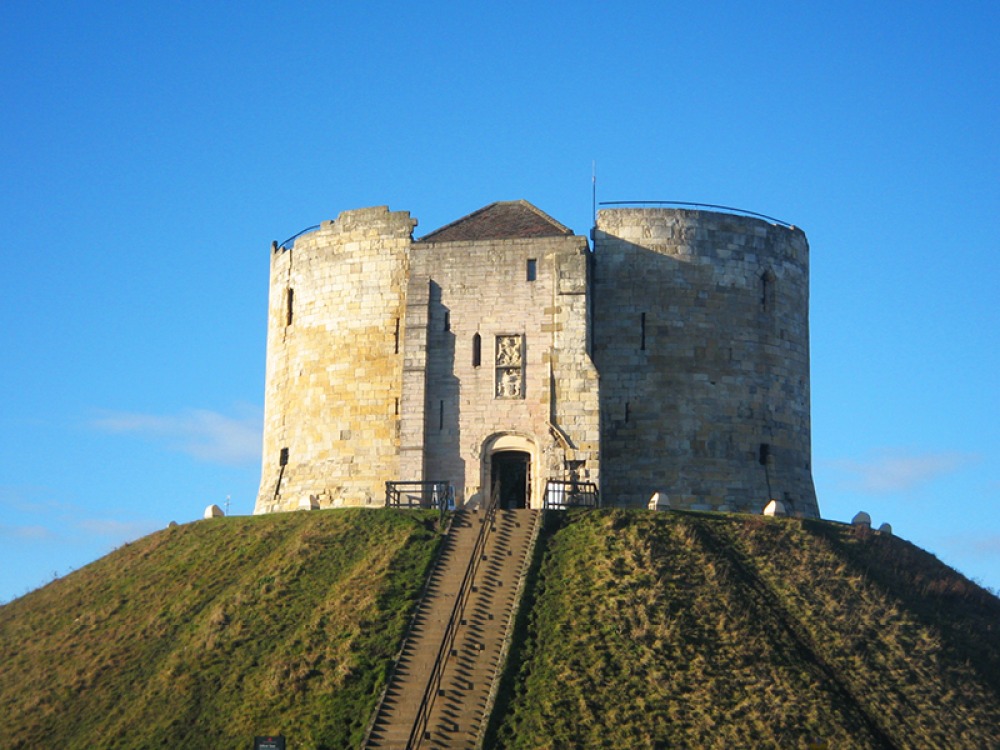
Jewish history is something York’s tourism authorities are keen to highlight. There is a walking map of the city’s medieval Jewish quarter, for example, along streets with names such as Jewbury and Jubbergate. Sacred Nowadays Clifford’s Tower is in the care of English Heritage, which treats it as a place of poignant memorial to victims of racial and religious intolerance. The tower’s present name, incidentally, is in memory of Sir Roger Clifford, the defeated leader of a rebellion against King Edward III, who was executed here in 1322.
Once inside the empty tower there is little to actually see, though much to think about. A Hebrew plaque unveiled in 1978 remembers the massacred Jews on the spot where some remains from a Jewish cemetery, unearthed during an archaeological dig in the 1970s, were reinterred in the presence of the British Chief Rabbi. Daffodils, their six petals and yellow colour symbolising the Star of David, are in flower on the anniversary of the massacre. And every 27 January, Holocaust Memorial Day, a vigil is held here remembering the victims of 1190 along with their millions of 20th-century counterparts.
Extracted from Britain’s Sacred Places: A Guide to Ancient and Modern Sites That Stir the Soul by Martin Symington (Bradt Guides).






